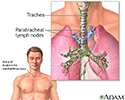Mediastinoscopy with biopsy
Mediastinoscopy with biopsy is a procedure in which a lighted instrument (mediastinoscope) is inserted in the space in the chest between the lungs (mediastinum). Tissue is taken (biopsy) from any unusual growth or lymph nodes.
This procedure is done in the hospital. You will be given general anesthesia so that you are asleep and do not feel any pain. A tube (endotracheal tube) is placed in your nose or mouth to help you breathe.
A small surgical cut is made just above the breastbone. A device called a mediastinoscope is inserted through this cut and gently passed into the mid-part of the chest.
Tissue samples are taken of the lymph nodes around the airways. The scope is then removed and the surgical cut is closed with stitches.
A chest x-ray will often be taken at the end of the procedure.
The procedure takes about 60 to 90 minutes.
How to Prepare for the Test
You must sign an informed consent form. You will not be able to have food or fluid for 8 hours before the test.
How the Test will Feel
You will be asleep during the procedure. There will be some tenderness at the site of the procedure afterward. You may have a sore throat.
Most people can leave the hospital the next morning.
In most cases, the result of the biopsy is ready in 5 to 7 days.
Why the Test is Performed
This procedure is done to look at and then biopsy lymph nodes or any other abnormal growths in the front part of the mediastinum, near your chest wall.
- The most common reason is to see if lung cancer (or another cancer) has spread to these lymph nodes. This is called staging.
- This procedure is also done for certain infections (tuberculosis, sarcoidosis) and autoimmune disorders.
Normal Results
Biopsies of lymph node tissues are normal and do not show signs of cancer or infection.
What Abnormal Results Mean
Abnormal findings may indicate:
- Hodgkin disease
- Lung cancer
- Lymphoma or other tumors
- Sarcoidosis
- The spread of disease from one body part to another
- Tuberculosis
Risks
There is a risk of puncturing the esophagus, trachea, or blood vessels. In some cases, this can lead to bleeding that can be life threatening. To fix the injury, the breastbone would need to be split and the chest opened.
References
Triplette M, Varghese TK, Cheng G-S. Mediastinal tumors and cysts. In: Broaddus VC, Ernst JD, King TE, et al, eds. Murray and Nadel's Textbook of Respiratory Medicine. 7th ed. Philadelphia, PA: Elsevier; 2022:chap 115.
Wald O, Izhar U, Sugar baker DJ. Lung chest wall, pleura and mediastinum. In: Townsend CM Jr, Beauchamp RD, Evers BM, Mattox KL, eds. Sabiston Textbook of Surgery. 21st ed. Philadelphia, PA: Elsevier; 2022:chap 58.
Review Date: 4/18/2022
Reviewed By: Mary C. Mancini, MD, PhD, Cardiothoracic Surgeon, Shreveport, LA. Review provided by VeriMed Healthcare Network. Also reviewed by David C. Dugdale, MD, Medical Director, Brenda Conaway, Editorial Director, and the A.D.A.M. Editorial team.







